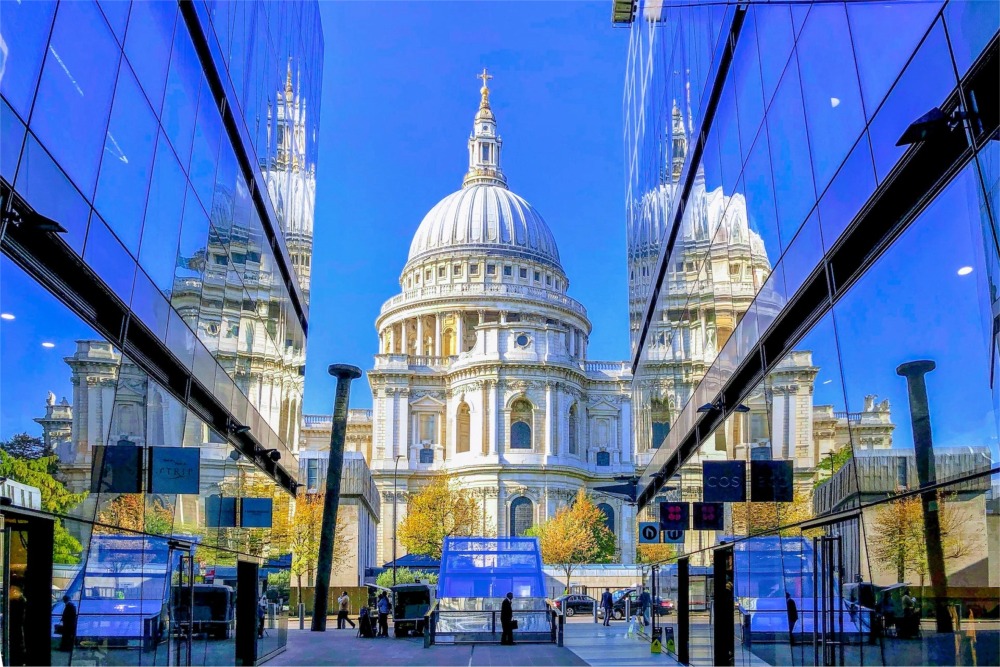St Paul's Cathedral
Home > Photos from England > St. Pauls Cathedral > St Paul's Cathedral the One New Change Building

From the One New Change building in London, England, the eastern facade of St Paul's Cathedral looks radiant as it has through all of these centuries past standing in memorial to all the people who came before us.
One New Change
One New Change is a major office and retail development in the City of London. It comprises 560,000 square feet (52,000 m2) of floor space, including 220,000 square feet (20,000 m2) of retail space and 330,000 square feet (31,000 m2) of office space and is the only large shopping centre in the City of London, the historic nucleus and modern financial centre of London. It cost £500 million to build and was completed in October 2010.
The complex is located on New Change, a road linking Cannon Street with Cheapside, in one of the areas of the City historically associated with retailing and markets. It is close to St Paul's Cathedral. The nearest London Underground stations are St Paul's and Mansion House.
History and background
The development's sensitive location — opposite St Paul's Cathedral — and its modern architecture led to some controversy during its planning and construction, including criticism from Prince Charles. The architect was Jean Nouvel and the developer was Land Securities. The new eight-story, 34 m high centre replaced an 11-storey, 40 m building constructed in the 1950s for the Bank of England, which was demolished in 2007. The complex's distinctive appearance has given it the nickname "the stealth bomber".
One New Change opened its doors to the public at midday on 28 October 2010. The roof terrace, with its restaurant and cafe, was opened on 18 November 2010.
Location
One New Change lies entirely within Bread Street ward. Its name derives from the road running between it and St Paul's, itself a post-War creation, replacing a much older street called Old Change. It is bounded by Cheapside to the north, Bread Street to the east, Watling Street to the south, and New Change to the west. Within the centre, the north-south arcade is called Cheapside Passage, and the east-west arcade is New Change Passage.
The shopping centre is located in an area of London's historic nucleus that was widely known for its retail — 'Cheapside' being Old English for "marketplace" — and many of the roads around One New Change are named after the produce once sold in the area, such as Poultry, Honey Lane, Milk Street, and Bread Street.
Design
The principal architect for the One New Change development was the French architect Jean Nouvel. The development also features high-profile interiors by Tom Dixon for the on-site restaurant Barbecoa, which was replaced by Ivy Asia in November 2019.
Tenants
Sixty shops and restaurants are located in One New Change, including a number of large high-street retailers. A barbecue restaurant and butcher called Barbecoa was a joint venture by Jamie Oliver and Adam Perry-Lang. It was replaced by Ivy Asia in November 2019.
The shopping centre is open seven days a week, which is notable as in recent times most shops and restaurants in the City have been closed at the weekends. A Gordon Ramsay restaurant and bar named Bread Street Kitchen opened at One New Change in September 2011.
St Paul's Cathedral
St Paul's Cathedral is an Anglican cathedral in London and is the seat of the Bishop of London. The cathedral serves as the mother church of the Diocese of London. It is on Ludgate Hill at the highest point of the City of London and is a Grade I listed building. Its dedication to Paul the Apostle dates back to the original church on this site, founded in AD 604. The present structure, dating from the late 17th century, was designed in the English Baroque style by Sir Christopher Wren. Its construction, completed in Wren's lifetime, was part of a major rebuilding programme in the city after the Great Fire of London. The earlier Gothic cathedral (Old St Paul's Cathedral), largely destroyed in the Great Fire, was a central focus for medieval and early modern London, including Paul's walk and St Paul's Churchyard, being the site of St. Paul's Cross.
The cathedral is one of the most famous and recognisable sights in London. Its dome, surrounded by the spires of Wren's City churches, has dominated the skyline for over 300 years. At 365 ft (111 m) high, it was the tallest building in London from 1710 to 1963. The dome is still one of the highest in the world. St Paul's is the second-largest church building in area in the United Kingdom, after Liverpool Cathedral.
Services held at St Paul's have included the funerals of Admiral Lord Nelson, the Duke of Wellington, Winston Churchill, and Margaret Thatcher; jubilee celebrations for Queen Victoria; an inauguration service for the Metropolitan Hospital Sunday Fund; peace services marking the end of the First and Second World Wars; the wedding of Prince Charles and Lady Diana Spencer; the launch of the Festival of Britain; and the thanksgiving services for the Silver, Golden, Diamond, and Platinum Jubilees and the 80th and 90th birthdays of Queen Elizabeth II. St Paul's Cathedral is the central subject of much promotional material and images of the dome surrounded by the smoke and fire of the Blitz. The cathedral is a working church with hourly prayer and daily services. The tourist entry fee at the door is £21 for adults (Summer 2022, cheaper if booked online), but no charges are made to worshippers attending advertised services.
The nearest underground station is St Paul's, which is 130 yards (120 m) away from St Paul's Cathedral.
From Wikipedia, the free encyclopedia.


